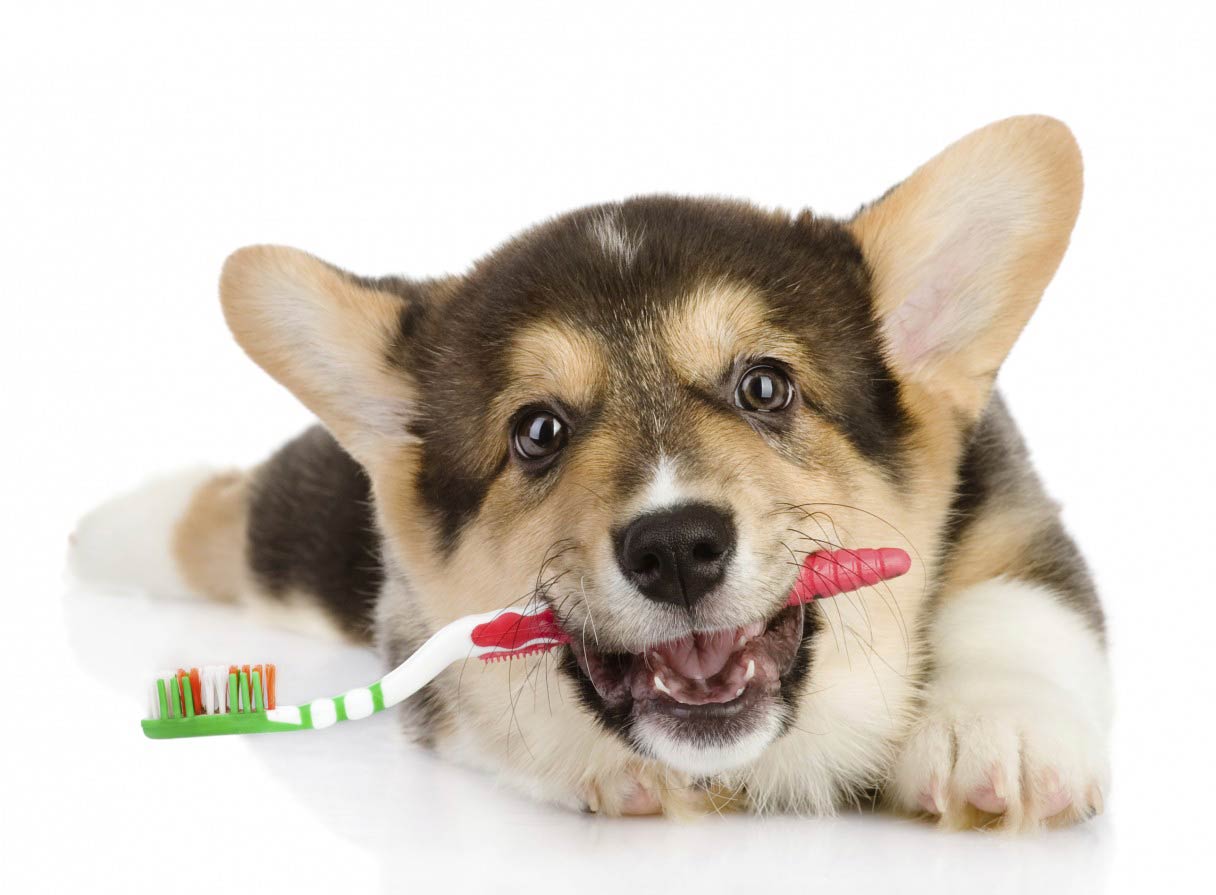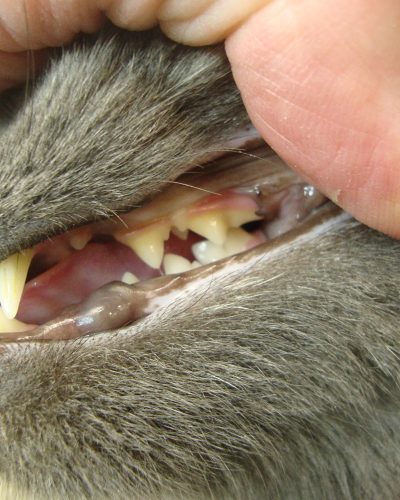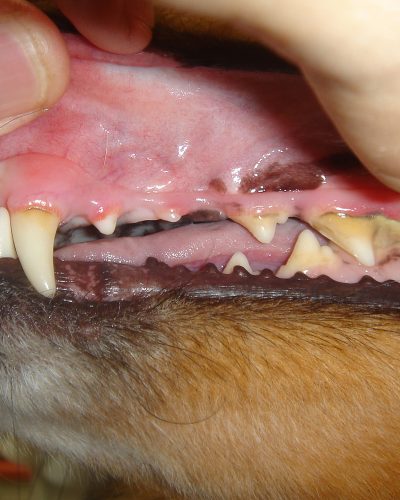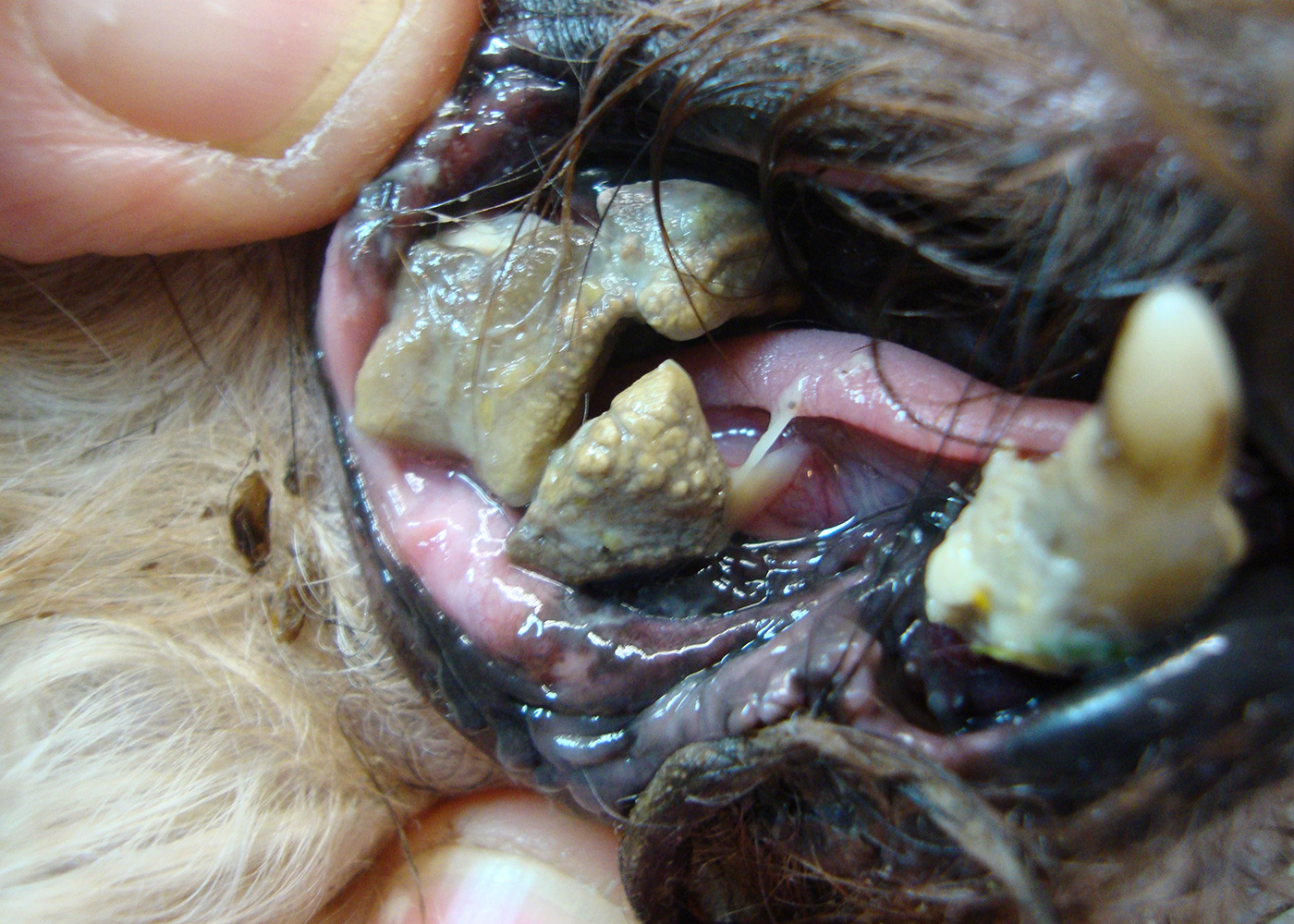It usually starts when noticing that our pet has bad breath. This is often because of diseased teeth and gums in our pet’s mouths. Bacteria thrive in this area, and if left untreated, can quickly turn into a problem. At first, bacteria lives on the surfaces of the teeth and gums, but if not removed regularly by brushing, wiping, or scaling/polishing, they will form plaque, tartar, and infect the gum tissue, causing inflammation called gingivitis. This can be reversed by thoroughly cleaning above and below the gumline, just as humans do by brushing twice a day and attending semi-annual trips to the dentist. If nothing is done, bacteria will travel deeper and deeper, infecting and destroying the bone that surrounds the roots of the teeth: this is called periodontal disease. Once that bone has been damaged, it cannot be repaired, and as this painful process continues, teeth will become loose and even eventually fall out. Remember, every pet will experience some degree of dental disease in their lifetime.
The problem with dental disease is that it is life shortening and painful for the pet. The worse it is, the shorter your pet’s life is likely to be and the more chronic pain there is. Animals tend to suffer in silence, which lulls us into thinking that the only real problem is the resultant bad breath. Even this halitosis can be enough to cause us to interact with and enjoy our pets much less affecting the human-animal relationship we share. Since our pets do not complain, they can end up suffering in relative isolation and we do not experience the fulfilling relationship with our pet that we originally wanted.
As with people, removal of soft plaque prior to mineralization is the key to maintaining oral care and reducing the need of professional intervention. Daily wiping/brushing of your dog’s teeth (after all food/treat consumption for the day), is very rewarding. Keep it simple, short and consistent. A little effort regularly is a whole lot more effective than an enormous effort occasionally.

Periodontal disease
Periodontal disease is a preventable disease. If dental disease is allowed to progress, the whole process snowballs and advanced disease of the gums and supporting bone ensues. As the gums become inflamed and retract, the roots of the teeth become accessible for bacterial colonization and the disease process accelerates, sometimes with irreversible consequences. Before we know it, we have a much older pet with a very seriously diseased and painful mouth (Grade III and IV periodontal disease). This is the situation that we really need to try to avoid by providing adequate home care coupled with proper professional dental prophylaxis, preferably by the time grade I or at most grade II disease has occurred. If the gums are even beginning to get red and/or swollen, then it is time for professional attention and treatment.
Left untreated, infection around your pet’s teeth can shed bacteria into the bloodstream, which can then cause liver, kidney or heart disease. Chronic infection and inflammation in your pet’s mouth will also take a toll on their immune system. Living with chronic toothaches will diminish your pet’s quality of life but we are here to help.
Ideal teeth. No plaque, tartar, or gingivitis
In Grade I PDDZ (Periodontal disease), sufficient soft plaque has accumulated and mineralized to create a “foundation” of calculus upon which an even faster build up of plaque/calculus then occurs. There is little to no gum or bone involvement generally, however many times some of the teeth are being more affected than others, commonly the canines and back premolars
In Grade I PDDZ (Periodontal disease), sufficient soft plaque has accumulated and mineralized to create a “foundation” of calculus upon which an even faster build up of plaque/calculus then occurs. There is little to no gum or bone involvement generally, however many times some of the teeth are being more affected than others, commonly the canines and back premolars
Grade 1 PDDZ
Building upon the foundation of calculus, even more calculus accumulates and the beginning of gingivitis (inflamed gums) may be noted. The calculus is starting to extend under the gums. Grades I and 2 involve primarily the outsides of the teeth surfaces, however the inner surfaces have begun the process of accumulating calculus. Treatment is done by scaling the calculus away above and below the gums, followed by gentle polishing of the teeth
Grade 2 PDDZ
Bacterial build up causes the gums to swell and turn a deep red color. The dental calculus spreads further under the gums along the root surface and invades bones. Serious discomfort, pain and bad breath set in; bacterial movement from the mouth to the heart valves and kidneys becomes more likely, and gum retraction progresses to expose the jaw bones themselves to the unchecked progression of bacterial infection, bone destruction, and root abcessation.
Grade 3 PDDZ
This is a crisis situation. The pet’s mouth becomes unbearably painful and stinky. The pets whole body bears the stress of this ongoing infection, inflammation and destruction. Crisis management would involve chronic pain management and chronic antibiotic use if left untreated. Grade 3 and 4 PDDZ often require extraction of abscessed teeth to help the mouth regain normalcy, all of which is based on dental radiographs that verify excessive bone loss and root tip abscessation. Antibiotics and pain medications are often needed during the pet’s recovery from anesthesia.
Grade 4 PDDZ
What Can We Do?
Just like we care for our own teeth and gums between dentist visits, by brushing, flossing and using mouthwash to remove plaque bacteria and food particles, your pet’s mouth deserves the same care. Our veterinarians and staff can show you how to brush or wipe your pet’s teeth and gums for daily plaque removal. There are also several products that can be helpful, such as foods and proper chewing items. We can help you find products that will be suitable, effective and safe for your pet. Another key part of preventative oral care is having your pet’s mouth examined regularly to detect problems early. This is usually done as a part of a full physical examination, which is recommended once yearly. If they will allow it, you should check your pet’s mouth regularly too, and bring any concerns to our attention.
Dental Prophylaxis
Prophylaxis means prevention. Dental prophylaxis is just that – the next level of preventative maintenance for your pet’s mouth. This is just like when you have your teeth cleaned at the dentist, and involves removal of the buildup of plaque and tartar from your pet’s teeth and under the gumline where it counts most.
A full oral exam is done, checking each tooth for problems such as gum disease, growths, fractures, or resorption. We then use ultrasonic scaler, which is an instrument that breaks up the tartar from the teeth without damaging or scraping the enamel. Polishing follows, to smooth any scratches on the tooth surface where plaque and tartar would otherwise easily build up later.
By removing the plaque and tartar, gingivitis is treated, and we are able to prevent deeper periodontal disease. Once your pet’s teeth are cleaned, you can start or continue your preventative oral care measures to help keep them as healthy as possible for as long as possible. Yearly dental cleaning is ideal.
In addition to scaling and polishing, we regularly take full-mouth radiographs to assess below the gumline. 60% of the tooth is below the surface and impossible to assess without X-rays. This helps us determine if a tooth should be extracted, or if it simply needs a cleaning.
Extractions
Unfortunately, it is common for us to find teeth that are beyond repair, and where extraction is the only or best treatment option. Examples of situations where extraction may be necessary include: Severe periodontal disease, fractures and tooth resorption. Extractions are much more involved than ‘pulling a tooth’ – teeth are designed to stay in the jaw against strong chewing forces, so pulling on them will only work if they are about to fall out like a baby tooth. Extraction requires stretching and cutting the strong fibrous ligament that attaches the root into the bony socket in the jaw, using special instruments called dental elevators and luxators. For multi-rooted teeth (majority of the teeth along the side of your pet’s mouth) it becomes even more involved because they have to be cut into sections so that each root can be removed individually. A flap of gum is moved out of the way, and bone is removed to allow access to the roots, then the tooth is cut into sections using a high-speed drill. The root’s attachment is severed until it can be lifted out of the socket. The final steps in any extraction are smoothing out any sharp points of bone, cleaning and flushing the socket, and suturing the gums closed.
Medication for pain relief will be administered and there will be a prescription sent home as well. Antibiotics may or may not be required. Usually soft or softened food is necessary for 1-2 weeks after extractions, mainly to prevent damage to the areas where gums have been stitched. Your pet will feel so much better after painful teeth have been removed from their mouth!
Radiographs of healthy teeth
Abscessed Teeth
Anesthesia
Even the calmest, most easy-going cat or dog won’t hold their mouth open and allow the veterinarian to probe around each tooth in an awake and conscious state – Let alone allowing for a full cleaning which can take 30-45 minutes! This is why anesthesia is required – for your pet’s safety and comfort, they need to be absolutely still while we do a thorough examination of their teeth and mouth, scale and polish teeth, perform dental x-rays, and extract diseased teeth.
Don’t worry – modern anesthetics are quite safe, and we do everything possible to further reduce the risk to your pet! Your pet will be evaluated prior to the procedure (usually with a thorough physical examination and bloodwork) to assess their anesthetic risk level. Our veterinarians will tailor the sedation, anesthetic and pain medication specifically for your pet, to ensure the safest and best outcome. Your pet will receive IV fluids, external warming, and be monitored closely during and after their procedure. Of course, it is natural to worry when a loved one is going to have a general anesthetic, but rest assured that your pet’s safety and comfort is a priority for us, just like if they were one of our own pets.








